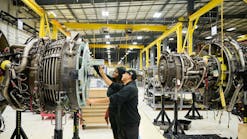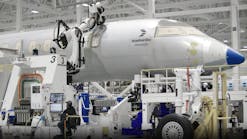Airport Consolidation: Unisys VP: Multi-airport systems offer an opportunity for better planning
Strategic Planning
Airport Consolidation
Unisys VP: Multi-airport systems offer an opportunity for better planning
By Chuck Sander, VP & Managing Partner, Unisys Airports
August 2004
The progress and development of transportation systems help definea nation’snature and identity. Significant changes in technology and managementwithin the aviation industry are reshaping how aviation and air transportationaffect national economies. One emerging trend in aviation is the development of consolidated, national-level multi-airport systems that are composed of regional complexes.
This consolidation of airports enables the development of regional and national systems that capitalize on the ability of designated airports either to serve specialized needs and particular market segments or to serve different types of passenger or cargo service.
Consolidation also makes it possible for airports to serve as the centerpieces of new economic areas or to function as transfer hubs in response to growing or changing demands.
Airport consolidation is a natural response to the current trend among airlines to organize themselves into worldwide groups such as Star Alliance, Northwest Airlines/KLM and Oneworld alliance. This airport consolidation movement, in turn, is paralleled in airport management, as companies such as BAA, SEA, Grupo Aeroportuario del Sureste (Asur), and Malaysia Airports Holdings Berhad (MAHB), which are taking over or own the operation of many commercial airports.
Even though airports and airlines provide international services, they have traditionally retained specific national characteristics. However, 21st century airlines and airports are developing international characteristics and “submerging their nationalities,” as one source puts it. That’s because today’s economic realities demand that aviation entities become global enterprises.
A recent example of this would be the Airports Authority of India privatizing (at present) 12 Airports, 49 percent of which can be private international/domestic ownership, and with the General Administration of Civil Aviation of China with current regulations that allow foreign investors to hold a combined share in domestic airports of up to 51 percent.
Consider the Multinational Corporation
To become global enterprises, aviation enterprises need to operate like
multinational corporations. This means they must focus on reducing
cost and increasing performance by establishing economies of scale and
implementing such practices as centralizing and simplifying their accounting
systems, eliminating and reducing duplication, centralizing procurement,
and standardizing their relationships with suppliers on a national and
international scale.
These changes will alter the relationship between government and airport operators. Although airports will continue to operate under local, national, and international regulation, they will cease to be run as municipal departments or local authorities. In some cases they may become privately traded corporations with stockholder ownership such as Auckland International, Beijing Airport, and Shanghai Airport.
The centralization of regional and national airports also affects how national airspace is allocated and organized, which can lead to the redefinition of airport usage and air traffic control systems. Such a reorganization can help reduce congestion and establish efficiencies through the use of national hub systems that will provide better and more effective regional service.
Consolidation is the most effective response to the inevitable growth of aviation traffic. Well-reasoned estimates of the aviation industry’s growth assume a twofold or threefold increase in traffic levels by 2025.
Historically, reducing costs has propelled aviation growth. To sustain another reduction in costs, the aviation industry will have to find more efficient modes of operation.
Effects on
Airport Traffic
Better managing airport traffic to reduce costs is one of the benefits
of airport consolidation. Airport traffic is no longer defined by destination
cities. National growth as well as city and regional growth now place
airports more than an hour from certain major cities. Traffic allocation
depends on a local airport’s ability to accommodate traffic and on
global competition among airlines.
As air traffic increases, demand can be divided among airports within a system. New, larger passenger and cargo aircraft mean that international gateways must no longer be located close to a nation’s borders or ocean coast. An example of this is the recent announcement for direct New York-to-Singapore service using the extended range A340-500 aircraft.
What was aircraft limitation is now eliminated and the requirement to make intermediate stops is no longer required. The new long-range aircraft have the potential to create new “destination” airports where services and support could be potentially less expensive than the traditional “port of entry” destinations of today.
Under traditional models, national and regional airports competed with one another for traffic. But it is no longer necessary for an airport to service all types of traffic under the consolidation approach. The trend is toward the development of specialized air facilities. These facilities often are dedicated to supporting and accommodating cargo and regional or low-fare airlines. National-level airport consolidation will facilitate the adaptation of existing facilities to these types of specialized services. For example, because cargo traffic has become a major element of several airport enterprises, several consolidation programs have designated specific cargo airports within their systems.
This application is especially meaningful, given the current structure of air cargo. The airline fleets of Federal Express and UPS are among the largest in the world. In terms of market capitalization, FedEx and UPS dwarf the largest commercial airlines: Market capitalization for UPS is $66.1 and for FedEx is $10.4 billion, compared with $7.8 billion for American Airlines and $2.6 billion for United Airlines. U.S. airports that have exploited this cargo niche include Louisville, KY, and Memphis, where more than 50 percent of operations are cargo operations. FedEx and UPS have also established international hub operations in Toronto; Liege, Belgium; and Manila.
Consolidation of airports into a regional or national multi-airport system enables the incremental development of primary airport elements to provide the necessary accessibility to compete with other regions for passenger, cargo, business, industrial, and tourist activity. It also enables the incremental development of additional capacity throughout the multi-airport system. This has been effective in Australia, where the federal government identified the need to develop additional airport capacity in Sydney and to support and protect the option for future expansion by maintaining and consolidating the Badgery’s Creek facility, in Sydney’s western suburbs, into the system.
Requirements for National Aviation Consolidation
The major challenge for airport consolidation is the proper management
and development of multi-airport systems. Unfortunately, the track
record in managing multi-airport systems has been poor, and consolidation
efforts have often been beset by expensive false starts and mistakes.
It is essential that those undertaking consolidation study and anticipate
the patterns of traffic distribution and traffic types among airports.
To do so, development plans must be strategic, and the overall plan must
adopt incremental change — phasing
investments and opportunities to ensure there is flexibility to adapt
to future evolutions.
Previous experiences with the development of multi-airport systems have shown these systems to be most effective when the assets and facilities operate outside the normal municipal or national bureaucracies and instead operate through an independent or semi-independent authority or company.
To maximize success, consolidated multi-airport systems must develop plans that allocate airlines and passengers so that all airports are assigned and support an established minimum level of traffic and service. Those involved in the consolidation of aviation systems must develop a vision and strategy of how and where they will develop the multi-airport system. This plan must include a detailed program of investment, including the identification of sources, incremental implementation schedules and baseline return on investment. These plans must also support the specific levels and types of traffic expected for each facility.
Specific Guidelines
The guidelines that were developed for an assessment of a strategic plan
for the Amsterdam Schiphol multi-airport system stress that planning must
be:
- Strategic — Planning must take the long-term view.
- Dynamic — Planning must recognize and thus anticipate the need
to adjust to meet the actual circumstances that eventually prevail.
Additionally, analysts have identified three essential elements that must be considered when evaluating the risk associated with the consolidation rationale: - Recognition of the risk;
- Analysis of the consequences of different choices at different periods, using what is known as decision analysis in operational research; and
- Choosing a strategy of development that commits only to immediate decisions and that buys flexibility to respond to future developments.
Airspace, Market Considerations
In terms of airspace management, suitable access corridors and their
related system facilities must be maintained or new ones provided to
foster the image that these facilities offer plausible opportunities for
expansion of passenger and cargo enterprises within the nation or region.
This approach requires that the new enterprise be developed and the consolidation
strategy be designed to accommodate the anticipated level of traffic and
anticipated growth, while remaining flexible enough to respond to changes
in the industry.
Consolidation requires the region or nation to develop a market strategy and business plan to include the solicitation and development of flights and routes that lend themselves to niche markets in the short term and to enterprise-specific markets that will support growth and development in the long term.
Consolidation enables the regional and national enterprises to reduce cost and increase performance. By establishing enterprise-size, consolidated airports, these systems will become large enough to take advantage of economies of scale in training and to implement best business practices across their organizations in a manner that is impracticable in local airports.
The End Results
These consolidations may radically change the operation and management
of airports. Through consolidation, future airport projects may well
be sponsored by global airport operating enterprises, which are entering
the national or regional system to obtain profits by applying effective
business practices and all but eliminating the need for public funding
or national-level investments.
This type of consolidation will result in enterprises operating over a set of airport systems, perhaps operating in coordination or association with international airline groups to provide an expanded group of services to the region or nation.
The result will be consolidated airport operations that employ a systems approach to national and regional development projects to achieve commercial, environmental, and political ends. The development of consolidated, multi-airport enterprises composed of regional airports and specialized complexes will yield a systematic, cooperative approach to national and regional airport planning.
Under this model, airports would no longer compete for business but instead would cooperate to build long-term, flexible enterprises capable of responding to and exploiting the ever-changing aviation market.
•“Strategic Planning for Airport Capacity: An Appreciation
of Australia’s Process for Sydney”; Australian
Planner, Vol. 29, No. 4, Dec. 1991, pp. 174-180.
• “Planning Multi-Airport Systems in Metropolitan Regions
in the 1990s”; Final Report for the U.S. Federal Aviation
Administration, DTFA01-92-P-012433, May 1994.
• “Economic and Complementary Criteria for the Selection
of Investments in Airport Projects”; Final Report for
the U.S. Federal Aviation Administration, DTRS-57-92-P-81083,
Dec. 1994.
• “Public Investment in the Aviation Transportation
Infrastructure”; Report 55, Special Workshop Sponsored
by the Transportation Research Board, Committee on Airfield
and Airspace Capacity and Delay, Oct. 1994, pp. 43-82.
• “Designing Airport Passenger Buildings for the 21st
Century”; Transport Journal, UK Institution of Civil
Engineers, Vol. 111, May 1995, pp. 83-96.
• “Management of Multi-Airport Systems: A Development
Strategy”; Proceedings of Airports 95 Conference, Sydney,
Australia, 9-11 Oct. 1995, pp. 1-13.
• “Management of Multi-Airport Systems: A Development
Strategy”; Journal of Air Transport Management, Vol.
2, No. 2, June 1995, pp. 99-110.
• “Policy Guidelines for the Option of a Development
of a Multi-Airport System, the Basis of a Dynamic Strategic Plan
to Provide the Capability for Flexible Response to Future Challenges”;
Report Prepared for Amsterdam Airport Schiphol, Netherlands,
1995.
• “Optimal Configuration of Complexes of Large Airport
Passenger Buildings and Their Internal Transport Systems”;
Proceedings, Airports of the Future, International Symposium Nov.
1995, Académie Nationale de l’Air et de l’Espace,
Cépaduès Editions, Paris, 1996, pp. 342-352.
• “Benchmarking Major Airports Worldwide”; ASCE
Journal of Transportation Engineering, TN 11639, Vol. 124,
No. 4, July/August 1998.
• “Airport Privatization Issues for the United States”;
Safety, Economic, Environmental, and Technical Issues in Air
Transportation, Transportation Research Record 1662, Paper 99.0218, 1999, pp.
24-31.
• Transportation Research Circular E-C027, “Airports
in the 21st Century: Proceedings of a Conference,” Transportation
Research Board, March 2001, pp. 90-115.
• “Multi-Airport Systems in the Era of No-Frills Airlines”;
Presented at Transportation Research
Board Conference, January 2003.






